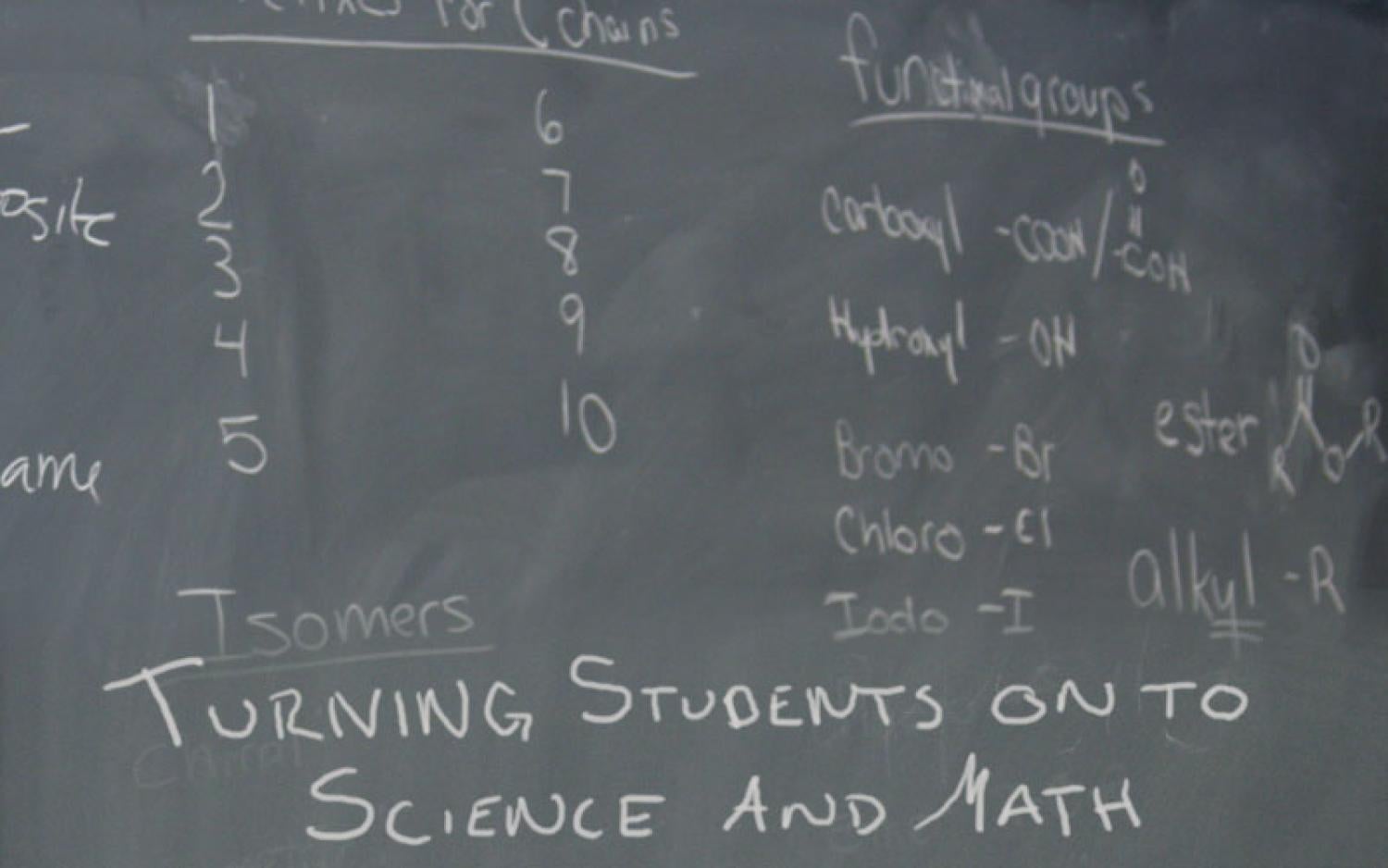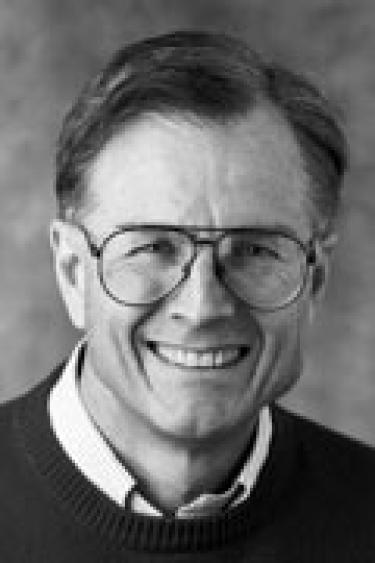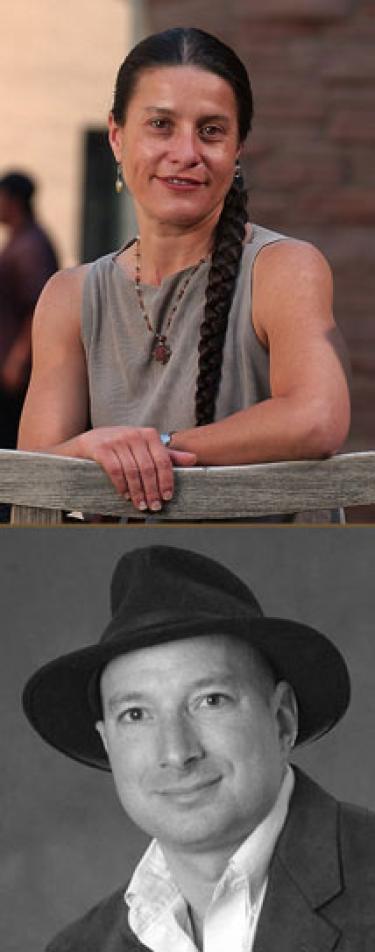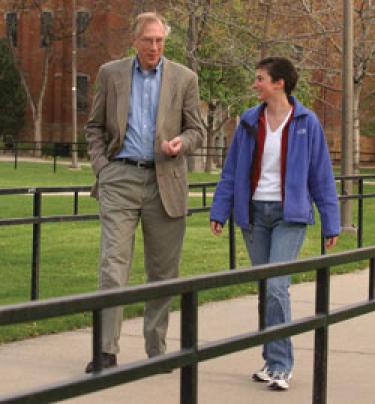
Responding to a national crisis, CU puts a fresh face on science and math education
Sarah Berger eyes a chalkboard crammed with notes on chemistry—prefixes for carbon chains, functional groups of organic compounds and indications of chirality of molecules.
Students in a University of Colorado biochemistry laboratory gaze ahead and are still.
Berger breaks the silence: “Who looks at all these pictures and says, ‘What?’”
Many hands rise.
“This looks a lot more complicated than it is,” she says. “I promise.”
For several minutes, Berger quizzes students on molecular structure, cis and trans molecules, carboxyl groups and hybridization. She pauses frequently, asking if the students are still with her.
When they are, she beams. “Lovely, lovely,” she says. “Beautiful!”
Finishing her stint at the chalkboard, Berger asks, “Feeling less sketchy about this?” They nod.
“I’m gonna let you do this,” she says. “Give it a whirl. Use this information.”
Then she’s off on a circuit around the lab, stopping to check with each student.
With the rounds done, she summarizes the day’s work at the chalkboard.
“This is trans-2-hexene. This is cis-2-hexene. Questions, anybody?”
None.
“No? We’re all good. We’re all happy campers.”
Berger leaves, heading to her next class. One student offers, “She’s the best.”
 Berger clearly likes teaching and teaches well. But she is neither a faculty member nor a graduate-student teaching assistant. She is an undergraduate, a sophomore in biochemistry and a learning assistant—or LA.
Berger clearly likes teaching and teaches well. But she is neither a faculty member nor a graduate-student teaching assistant. She is an undergraduate, a sophomore in biochemistry and a learning assistant—or LA.
As she explains, students are comfortable with her because “they know that I don’t have all the answers either, so they don’t feel like I’ll think their questions are silly or dumb.”
Additionally, she says, graduate teaching assistants and professors have learned so much that they might “glaze over” concepts that students don’t understand.
Since 2003, CU’s Learning Assistant Program has been enhancing large-enrollment science courses for three purposes:
—recruiting and training talented K-12 science teachers,
—encouraging faculty to recruit future science teachers, and
—improving science education for all undergraduates.
The gathering storm
 CU astrophysicist and Distinguished Professor Richard McCray originally conceived of the program in response to pressing national needs.
CU astrophysicist and Distinguished Professor Richard McCray originally conceived of the program in response to pressing national needs.
In a 2007 report called “Rising Above the Gathering Storm,” The National Academies argued that America’s faltering standing in science and engineering will “inevitably degrade its social and economic conditions and in particular erode the ability of its citizens to compete for high-quality jobs.”
The report’s top recommendation was “vastly improving K-12 science and mathematics education.” The aim: annually recruiting 10,000 science and math teachers to educate 10 million students.
In 2001, the U.S. Commission on National Security-21st Century concluded that American systems of research and education were foundering as other countries’ were improving. “The inadequacies of our systems of research and education pose a greater threat to U.S. national security over the next quarter century than any potential conventional war that we might imagine.”
One might therefore say that Berger is helping to preserve national security. But the LA Program is a piece of a broader effort.
The Learning Assistant program is part of CU’s Integrating Science, Technology, Engineering, & Math Education initiative, also known as iSTEM. The iSTEM initiative, which includes the nationally recognized CU Teach program, is jointly supported by the College of Arts and Sciences, the School of Education and the College of Engineering and Applied Science.
By seeking to recruit K-12 teachers who’ve mastered science and math, and by improving the science and math education of other undergraduates, the LA Program answers the nation’s call to action.
Evidence shows CU’s answer is effective.
The LA Program has enriched more than 35 courses. CU hires about 80 learning assistants per semester. It costs about $3,000 per year per LA, who help teach about 8,000 students annually.
 Valerie Otero, a CU associate professor of education who is the dynamo behind the LA Program and a co-director of the iSTEM program, says this is a bargain. It costs about $51 per year per student taught. And the impact is significant.
Valerie Otero, a CU associate professor of education who is the dynamo behind the LA Program and a co-director of the iSTEM program, says this is a bargain. It costs about $51 per year per student taught. And the impact is significant.
The LA Program administers assessment tests before and after selected science and math courses. Science students who are coached by a learning assistant score higher—and learn more—than those not coached by LAs.
Learning assistants themselves score even higher. Such data indicate that learning assistants know their stuff, which will help them—and the nation—regardless of whether they become research professors or high-school physics teachers.
Otero notes that the Learning Assistant Program has been replicated in at least 12 universities nationwide.
“We teach civic responsibility,” Otero says. Students, she says, have “got to make a move on education. They can’t just sit back and settle for antiquated models of teaching and learning.”
Noah Finkelstein, an associate professor of physics and one of the directors of the iSTEM program, underscores the urgency. He quotes the U.S. secretary of education, who has said that education is an “economic imperative,” a “moral obligation of society” and “the civil rights issue of our generation.”
Among America’s international peers, Finkelstein says, “The United States outperforms nobody and is outperformed by a slew of other countries.” In some respects, he adds, U.S. students perform on par with those in Latvia, Turkey, Mexico and Greece.
By some measures, Colorado’s K-12 educational system is about middle of the pack nationwide, he says. “But middle of the pack in the bottom tier is not necessarily where you want to be.”
Furthermore, there are achievement gaps between racial minorities and Caucasians, and those gaps are widening.
“We have a grave problem,” Finkelstein observes.
Like Otero, Finkelstein underscores the national crisis and emphasizes that iSTEM and its LA Program advance at least three of CU-Boulder’s strategic goals: “enhancing education and scholarship,” “experiential learning” and “transcending academic boundaries.”
Further, Finkelstein says that investing in initiatives like the Learning Assistant Program is R&D for education. And education, he adds, is “the mechanism by which society replicates itself and hence is the fundamental form of investment in the future.” (Read a summary of his February 2010 congressional testimony on STEM education here.)
Otero, Finkelstein and others note that university professors tend not to encourage bright students to pursue K-12 teaching. The LA Program is changing that institutional bias.
But how do you encourage bright science students to become K-12 teachers, or even to stay in the natural sciences? Step one, Finkelstein says, is to “stop beating the interest out of them.”
Good advice. Prominent scientists concur.
Nobel laureates weigh in
 Thomas Cech, a CU distinguished professor of chemistry and a Nobel laureate in chemistry, has repeatedly espoused better science education. In a 2005 editorial in the prestigious journal Science, Cech and Science Editor-in-Chief Donald Kennedy highlighted the case of a student named Kate, who excelled in high-school science and could have been a promising scientist.
Thomas Cech, a CU distinguished professor of chemistry and a Nobel laureate in chemistry, has repeatedly espoused better science education. In a 2005 editorial in the prestigious journal Science, Cech and Science Editor-in-Chief Donald Kennedy highlighted the case of a student named Kate, who excelled in high-school science and could have been a promising scientist.
“It took only one year of science classes at a large research university to turn Kate into a business major,” Cech and Kennedy wrote.
But why care about Kate? For one thing, Cech and Kennedy noted, proportionately fewer U.S. students (compared to foreign students) get advanced degrees in science and engineering. That disparity hinders U.S. competitiveness in these fields.
Also, “The future of the world is at stake! … Never have exciting new developments in science been more tightly connected to real dilemmas in public policy.” For those reasons, they wrote, science education must stop deterring future Kates.
Cech follows his own advice. In the general-chemistry course he teaches at CU, he works with four student LAs who act as “learning coaches,” Cech notes.
“Instead of telling them the answers to difficult chem problems, they guide teams of students to discover the answers for themselves.”
Learning assistants, who are selected for their interest in science education, help society because many go on to become “superbly trained” K-12 science teachers. “The LAs often become the rare (unfortunately) science teacher who is expert at the scientific concepts, but also expert at explaining them to young people.”
 Carl Wieman, a CU distinguished professor of physics and a Nobel laureate in physics, has long worked to improve science education and used LAs in his own classes while at CU. Wieman, who is also director of the Carl Wieman Science Education Initiative at the University of British Columbia, Vancouver, recently penned an editorial for Science in which he lamented that the “traditional lecture model continues to dominate, particularly at large research universities.”
Carl Wieman, a CU distinguished professor of physics and a Nobel laureate in physics, has long worked to improve science education and used LAs in his own classes while at CU. Wieman, who is also director of the Carl Wieman Science Education Initiative at the University of British Columbia, Vancouver, recently penned an editorial for Science in which he lamented that the “traditional lecture model continues to dominate, particularly at large research universities.”
Wieman noted that “innovative teaching methods improve student learning and are practical to implement,” yet remain at the periphery.
The Learning Assistant Program is one such initiative. Wieman notes that he is not unbiased, given his involvement with the original National Science Foundation proposal that started the LA Program, and given his service on a board that funds initiatives like the LA Program nationwide.
Citing the “terrible shortage” of K-12 teachers highly skilled in math and science, Wieman adds: “The evidence shows that having a middle- or high-school science teacher with a deep understanding of the subject matter does not guarantee a good education, but if the teacher does not have such an understanding, it pretty much guarantees a bad science education.”
“We also see that students going through the LA Program are themselves gaining an extraordinarily good education in science, regardless of what career they choose to pursue, and their influence beneficially impacts the education of the students around them.”
Not ‘beating the interest out of them’
As Otero emphasizes, undergraduate learning assistants help to transform large-enrollment science and math courses. In a traditional course, an instructor lectures to a large classroom of, say, 200 or more students. A graduate teaching assistant may also conduct recitations.
A course enhanced via the LA model, however, disperses the teaching load and increases collaboration among students. Students form small “learning teams” of six to 20 students that are coached by an LA. Several LAs might serve one course.
Though LAs are selected for their skill in science, they still need to learn the science behind education and teaching.
Biochemistry students see Sarah Berger in action. They don’t see her preparatory work.
Once a week, each LA meets with the instructor for planning sessions. And once a week, LAs who help students in physics, chemistry, biology and mathematics take a weekly course in education theory and practice—pedagogy. A faculty member from the CU School of Education and a K-12 teacher jointly teach the pedagogy course.
At 6 p.m. on a recent Wednesday, a room full of undergraduate LAs met for a pedagogy session. While eating pizza, they discussed their recent teaching challenges—such as students who insist on knowing a problem’s answer rather than learning how to solve such problems
Then the class turned to theories of teaching. Otero was team-teaching with Steve Iona, a retired high-school science and math teacher. They led a discussion about metacognition—thinking about thinking—and argumentation, both of which are key to teaching.
Iona taught in high schools for 30 years and now teaches physics at the University of Denver. At CU, he’s been helping with faculty workshops, teacher workshops and LA pedagogy for seven years.
“As a high-school classroom teacher, I want to teach with excellent colleagues—those who know and care about science and those who know and care about education and the students,” Iona says. “The Learning Assistant Program helps find and develop that excellence. The next generation of teachers is going to be even better that the last.”
How can we know that? The LA Program relies on the scientific method: testing hypotheses and adopting techniques that work.
The LA Program also encourages faculty members to see teaching through fresh eyes. As Otero reported in a 2006 edition of Science, one not-atypical faculty member put it this way:
“I’ve taught (this course) a million times. I could do it in my sleep without preparing a lesson. But (now) I’m spending a lot of time preparing lessons for (students), trying to think, ‘OK, first of all, what is the main concept that I’m trying to get across here?’ … Which I have to admit I haven’t spent a lot of time in the past thinking about.”
And while faculty engagement and student learning are improving, a core goal of the LA Program is being attained: More students are choosing K-12 teaching as a career.
As Otero notes, the program has tripled the number of CU students who become certified to teach math and sciences at the secondary level.
A case in point is Sarah Berger, a native of Winter Park who says the LA experience is “right up my alley.”
After earning her biochemistry degree, Berger could pursue a career in research. But she intends to teach chemistry at the high-school level.



